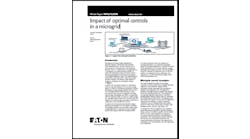Capitalizing on the Wholesale Market with Your Distributed Energy Resources
Nicholas Buckley
John Sasso
Wholesale electricity sales can bring year-round sustainable value to distributed energy resources. But how can microgrids capitalize on these markets? Nicholas Buckley and John Sasso of RRT SIGMA Engineering offer a tutorial.
The Distributed Energy Resource (DER) is a key component of having an effective and self-sustainable microgrid. Gas turbines and reciprocating engines, have been, and still are, a popular selection for the DER. However, the capital investment of the DER may prove difficult to justify for those potentially few hours per year when the grid power is interrupted.
More often the DER must bring more year-round benefit to generate sustainable value. This can be through (a) use of a heat recovery system from the DER, (b) electric capacity sales, (c) retail electricity sales and (d) wholesale electricity sales. In this article, we will address item (d).
To determine the market for wholesale electric we must first understand how the energy market works. In deregulated states such as New York State, the Independent System Operator (ISO) purchases power three different ways: Bilateral contracts, the Day-Ahead Market (DAM), and the Real-Time Market (RTM).
Bilateral contracts are simply agreements between a power supplier and a power buyer for an agreed upon amount of electric energy at a pre-determined price structure over an agreed upon period of time. However the majority of electricity purchases are made in the DAM.
The ISO and Regional Transmission Owners (RTOs) forecast how much electricity is needed the next day. Power suppliers then submit bids into the DAM for the quantity of electricity they are prepared to produce each hour of the next day and the price they require to produce that electricity. Based on the forecasted load the ISO will select enough generation from the power supplier bids beginning with the lowest price offer and progressing through to the more expensive offers. Once the generation bids selected meets the demand forecast, each selected power supplier bidder will be awarded the clearing price, i.e. the bid price of the last selected unit required to meet the load forecast. This electronic auction is conducted daily over the internet. Similarly during the day of, power suppliers bid into the Hour Ahead Market (HAM) and the ISO selects the lowest-priced power suppliers to match the marginal hour ahead demand needs. Real time power prices are used to adjust actual compared to scheduled electric deliveries.
To assess the extent the DER can produce power competitively in the DAM and improve the project return, one must first identify the operating costs for the DER to bid into the DAM. Let’s say the DER is a reciprocating engine generator with natural gas as its fuel source. The main factors that affect the variable cost of producing power are the heat rate of the engine-generator, the cost of the fuel, plus any O&M accrual. In our case, let’s assume the reciprocating engine has a heat rate of 8,000/kWh and natural gas can be delivered to the microgrid site for 6/dth. Based on that information the cost of generation can be calculated:
To this we can also include an O&M variable costs for this type of engine however we will ignore that component for our example. When we compare that operating cost ($48/MWh with a gas price of $6/dth) to the DAM clearing price for every hour of the year, we can tally the number of the hours the DER is profitable to operate and the associated difference between the DAM clearing price and the DER operating cost. RRT SIGMA has created a visual, 3D plot of the historical data for Zone J (NYC, NYISO) and Zone K (Long Island, NYISO) and Linden, NJ (VFT, PJM) which are found in Figures 1, 2, and 3 respectively. From the tabulated values, one can determine how often the microgrid’s DER would have outperformed the prices of the DAM and estimate the financial benefit from self-generating power and selling available power to the market from the DER versus purchasing power from the DAM. As seen in the figures, there are many hours throughout the year where the DAM prices are greater than 50 (i.e. not colored blue). During these hours the DER can be operated for less than the DAM clearing price thereby creating a revenue stream for the microgrid from the sale of electricity. Therefore, the DER efficiency and cost of fuel are very important factors when selecting a generation source for a microgrid.
Figure 1: 2014 NYISO Zone J DAM (NYC)
Figure 2: 2014 NYISO Zone K DAM (Long Island, NY)
Figure 3: 2014 PJM VFT DAM (Linden, NJ)
Nicholas Buckley is a mechanical engineer and John Sasso is a project manager at RRT SIGMA Engineering, a provider of engineering, consulting and construction services to the energy sector. They can be reached at [email protected] and [email protected]. More information about RRT SIGMA Engineering can be found at www.rrtsigma.com.







